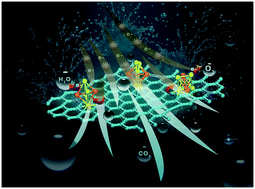Vanadium tetrasulfide cross-linking graphene-like carbon driving a sustainable electron supply chain from pollutants through the activation of dissolved oxygen and hydrogen peroxide†
Abstract
Excessive energy consumption and low reaction efficiency caused by electron cycle rate limitations are bottlenecks in water treatment. Here, we introduce an innovative strategy to overcome this problem via constructing a novel three-dimensional (3D) hybrid of vanadium tetrasulfide cross-linking graphene-like carbon with π electrons (VSO–C(π)), which exhibits excellent performance during refractory pollutant removal based on sustainable electron cycling between hydrogen peroxide (H2O2), dissolved oxygen (DO), and pollutants at the solid–liquid micro-interface. VSO–C(π) is synthesized through an in situ hydrothermal synthesis procedure and characterized via a series of techniques. The cation-π structures are constructed through V–S–C(π) and V–O–C(π) bridges in VSO–C(π), triggering orientable electron transfer from C(π) to the metal V centers and forming a polarized distribution of surface electrons. In the VSO–C(π)/pollutants/DO/H2O2 system, the pollutants act as electron donors to C(π), with the subsequent degradation of pollutants, while DO and H2O2 act as electron acceptors and are activated by reactive oxygen species to further degrade the pollutants at the V centers. This sustainable electron cycling process is responsible for the excellent activity and superior adaptability to pH changes and different salt environments, while also greatly saving resources and reducing energy consumption.



 Please wait while we load your content...
Please wait while we load your content...